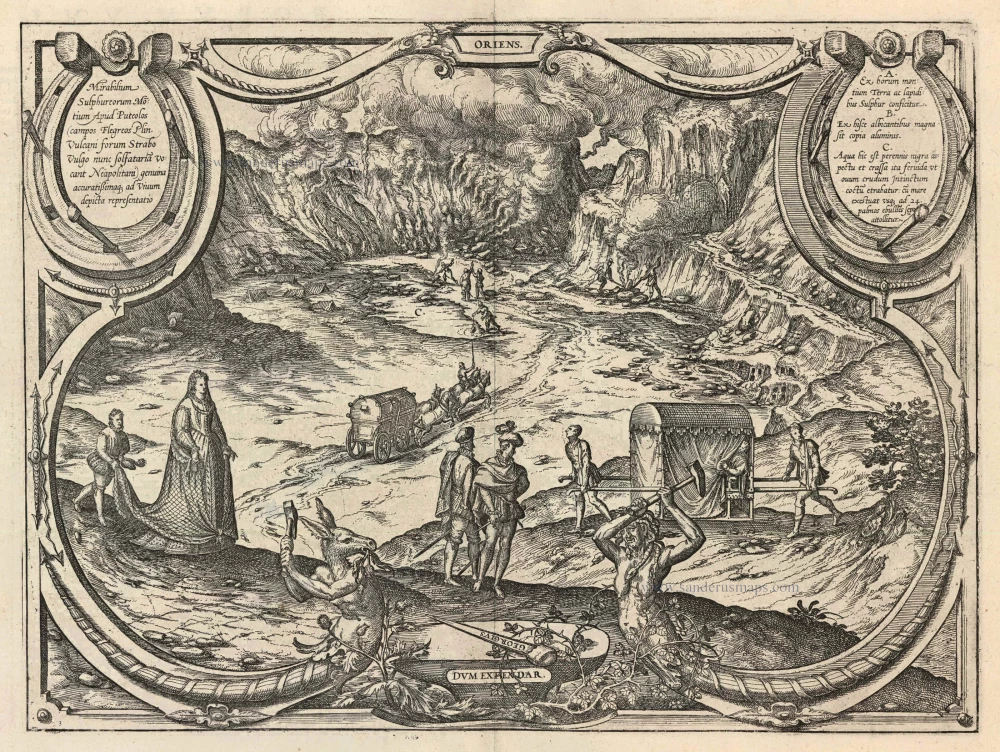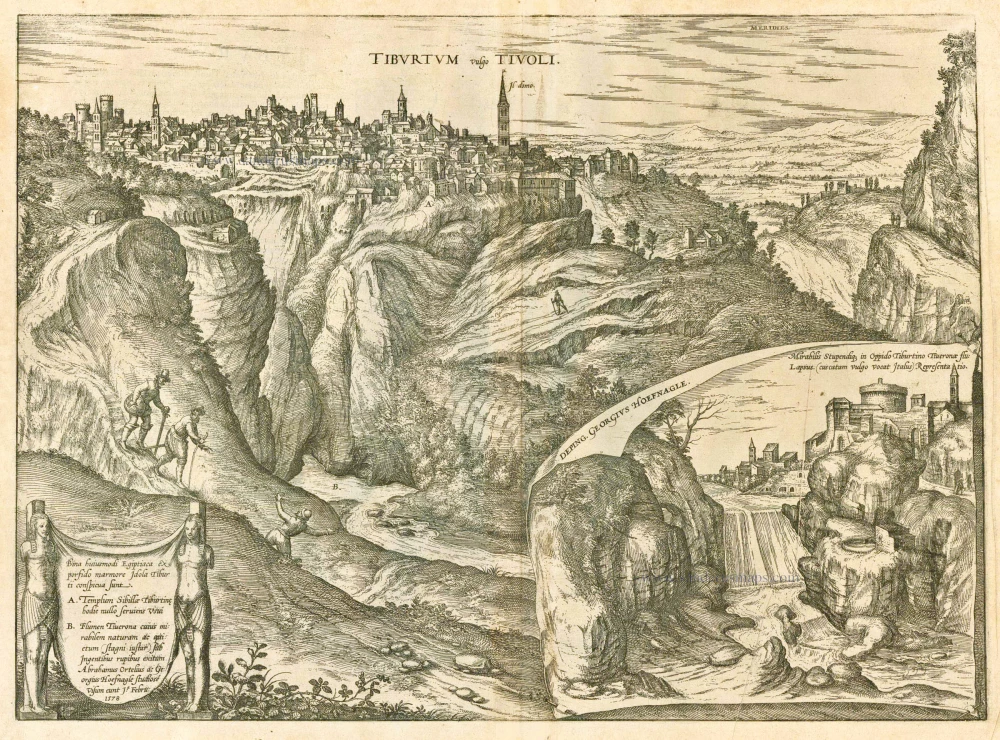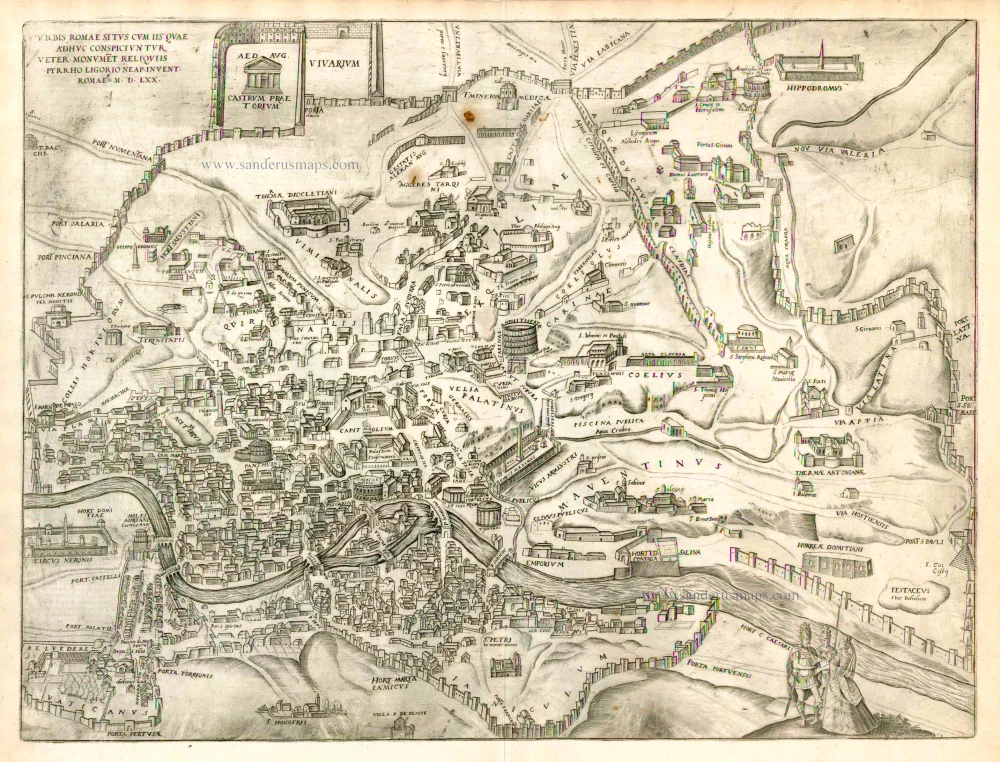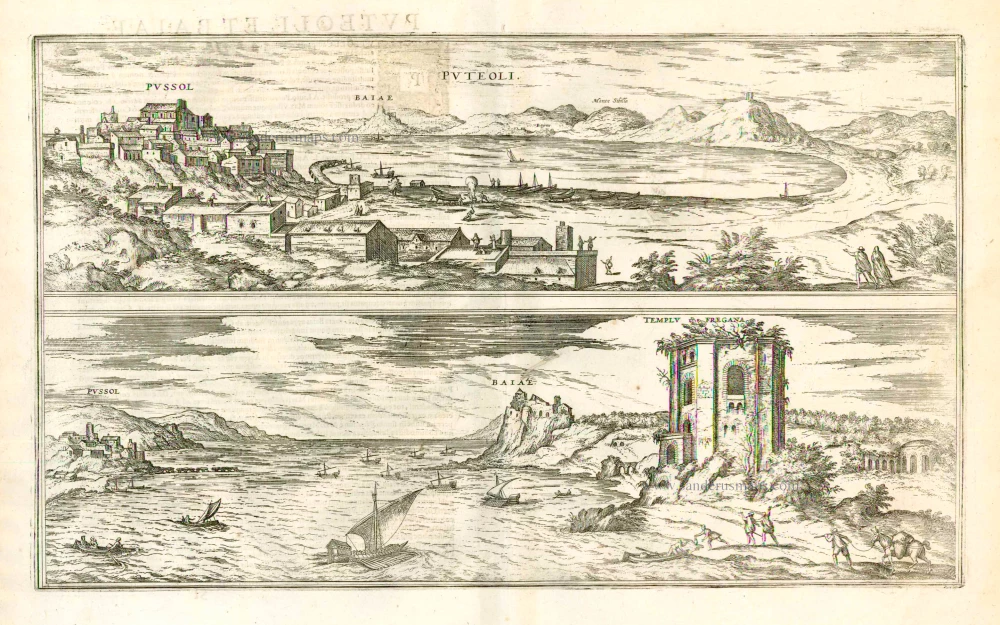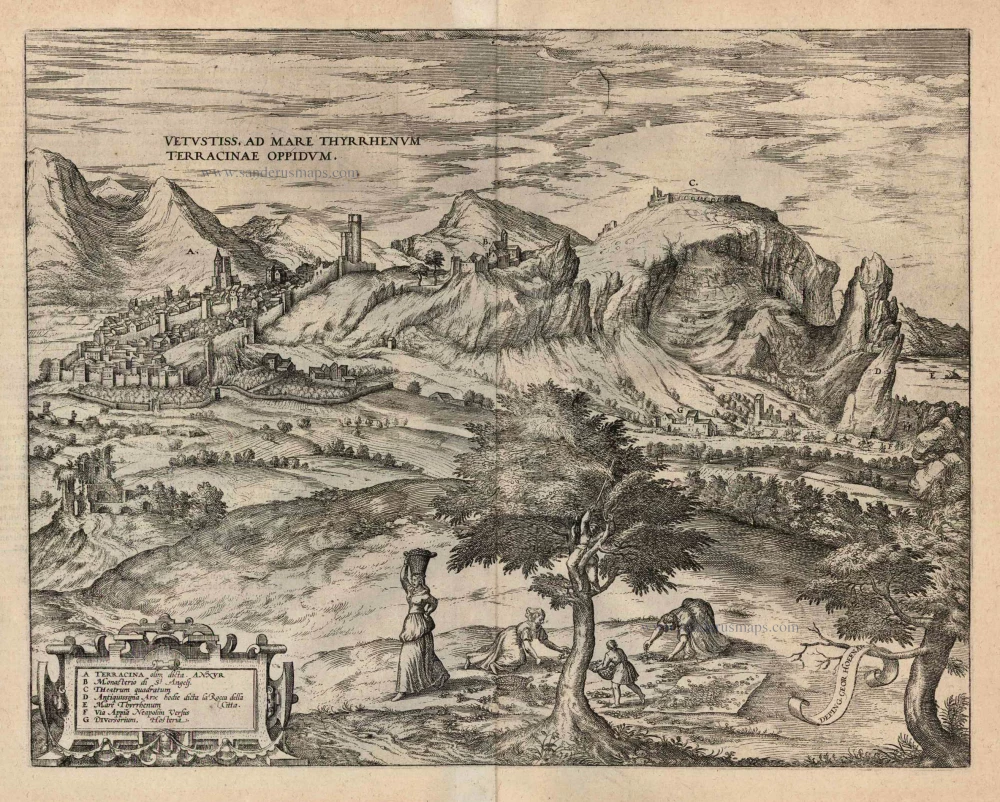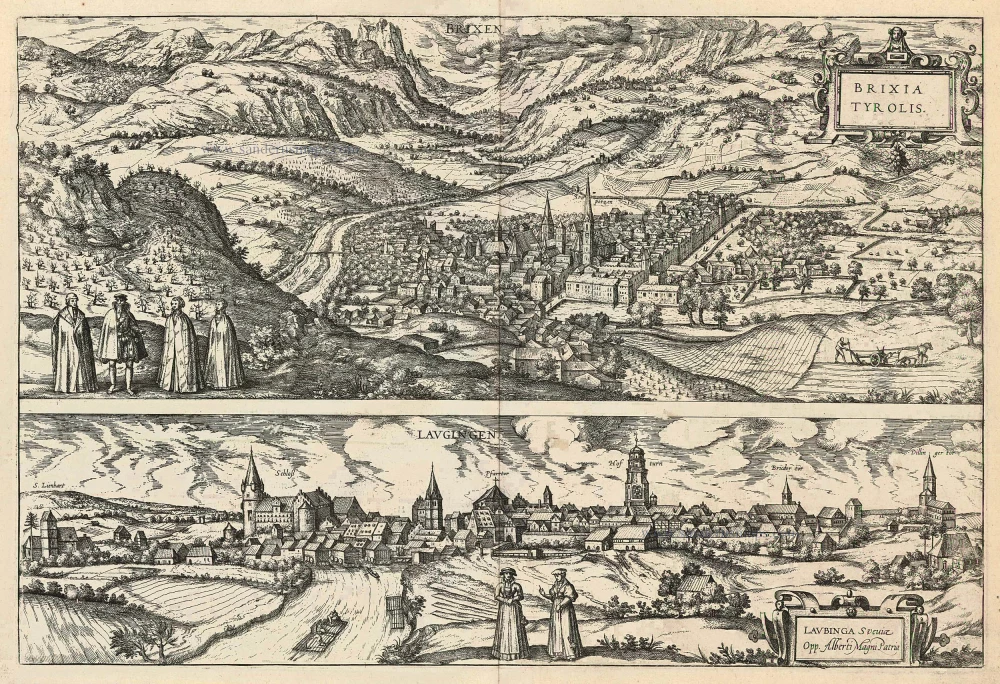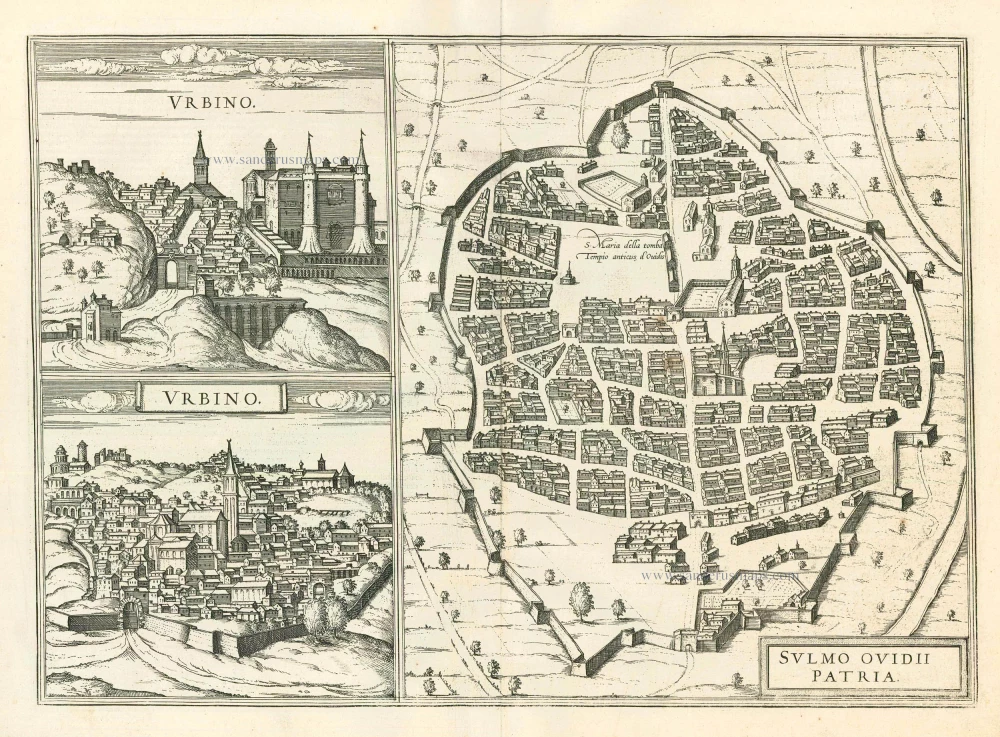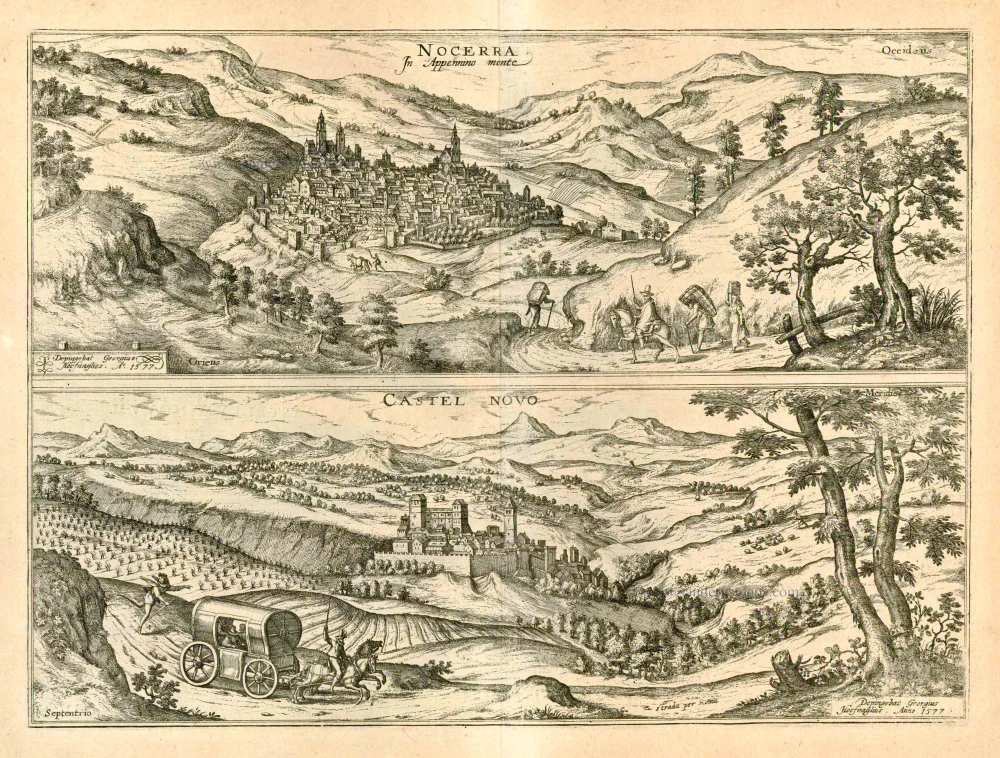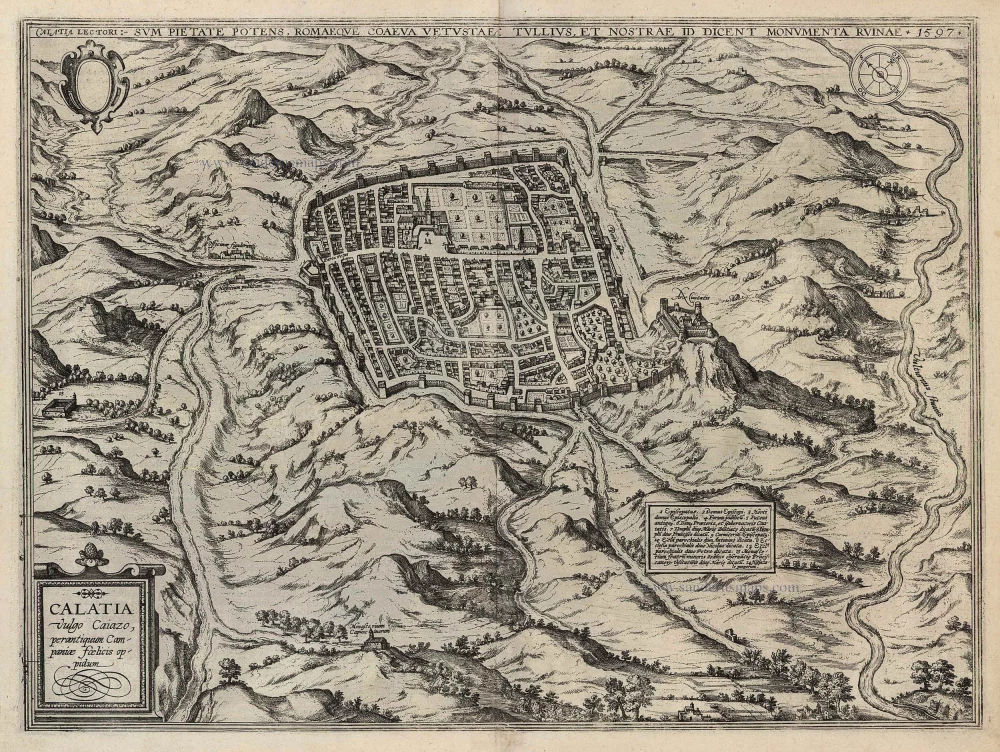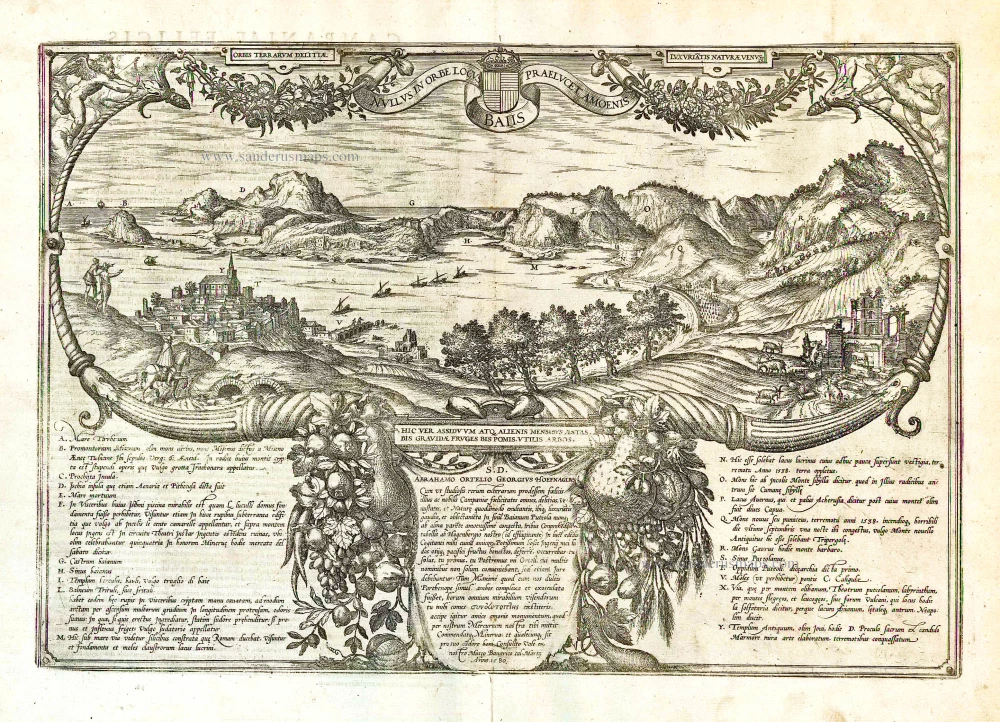The Phlegraean Fields (Campi Flegrei), by Braun and Hogenberg. 1599
Phlegraean Fields, also known as the Campi Flegrei, is a large 13 km (8 mi) wide caldera west of Naples, Italy. Today most of the area lies underwater, including Pozzuoli and the Solfatara crater, the mythological home of the Roman god of fire, Vulcan.
CARTOUCHE LEFT: A true-to-life and accurate illustration of the great sulphur mountains near Pozzuoli (Campi Flegrei in Pliny, Vulcani forum in Strabo, Solfatara in Italian among the Neapolitans today).
COMMENTARY BY BRAUN: "Solfatara is a place in Campania that is truly wonderful. The first thing one sees is a broad egg-shaped field, somewhat longer than wide. This is surrounded by high hills as if by a wall or bastions, and only a single entrance faces Pozzuoli. The soil is mixed through and through with brimstone, which grows there, and at the end, there is a wide pit full of black and thickened water. All around the pit, pungent and hot sulphur fumes constantly arise from holes in the ground. Beside it, there are many smelteries where white sulphur is made."
This unusual plate underlines the dramatic nature of the deadly sulphurous vapours from the ground. The allegorical figures with a donkey's head and a Medusa's head who are striking an anvil with smiths' hammers and the cartouche texts framed by horseshoes reference the forge of the god Vulcan. In the middle, we see the artist (Georg Hoefnagel) and the scholar (Abraham Ortelius) discussing in detail what they see (C: "The water here is always black, muddy and so hot that if an egg is put in it, it will come out cooked; the water bubbles like the sea and often surges up to a height of 24 handbreadths"). The Greeks founded their oldest colony on the Italian mainland near Phlegraean Fields. Since antiquity, travellers have been fascinated by these volcanic hills with their hot springs and craters, vividly portrayed by Georg Hoefnagel. (Taschen)
Braun G. & Hogenberg F. and the Civitates Orbis Terrarum.
The Civitates Orbis Terrarum, also known as the 'Braun & Hogenberg', is a six-volume town atlas and the most excellent book of town views and plans ever published: 363 engravings, sometimes beautifully coloured. It was one of the best-selling works in the last quarter of the 16th century. Georg Braun, a skilled writer, wrote the text accompanying the plans and views on the verso. Many plates were engraved after the original drawings of a professional artist, Joris Hoefnagel (1542-1600). The first volume was published in Latin in 1572 and the sixth in 1617. Frans Hogenberg, a talented engraver, created the tables for volumes I through IV, and Simon van den Neuwel made those for volumes V and VI. Other contributors were cartographers Daniel Freese and Heinrich Rantzau, who provided valuable geographical information. Works by Jacob van Deventer, Sebastian Münster, and Johannes Stumpf were also used as references. Translations appeared in German and French, making the atlas accessible to a broader audience.
Since its original publication of volume 1 in 1572, the Civitates Orbis Terrarum has left an indelible mark on the history of cartography. Seven more editions followed the first volume in 1575, 1577, 1582, 1588, 1593, 1599, and 1612. Vol.2, initially released in 1575, saw subsequent editions in 1597 and 1612. The subsequent volumes, each a treasure trove of historical insights, graced the world in 1581, 1588, 1593, 1599, and 1606. The German translation of the first volume, a testament to its widespread appeal, debuted in 1574, followed by the French edition in 1575.
Several printers were involved: Theodor Graminaeus, Heinrich von Aich, Gottfried von Kempen, Johannis Sinniger, Bertram Buchholtz, and Peter von Brachel, all of whom worked in Cologne.
Georg Braun (1541-1622)
Georg Braun, the author of the text accompanying the plans and views in the Civitates Orbis Terrarum, was born in Cologne in 1541. After his studies in Cologne, he entered the Jesuit Order as a novice, indicating his commitment to learning and intellectual pursuits. In 1561, he obtained his bachelor's degree; in 1562, he received his Magister Artium, further demonstrating his academic achievements. Although he left the Jesuit Order, he continued his studies in theology, gaining a licentiate in theology. His theological background likely influenced the content and tone of the text in the Civitates Orbis Terrarum, adding a unique perspective to the work.
Frans Hogenberg (1535-1590)
Frans Hogenberg was a Flemish and German painter, engraver, and mapmaker. He was born in Mechelen as the son of Nicolaas Hogenberg.
By the end of the 1560s, Frans Hogenberg was employed upon Abraham Ortelius's Theatrum Orbis Terrarum, published in 1570; he is named an engraver of numerous maps. In 1568, he was banned from Antwerp by the Duke of Alva and travelled to London, where he stayed a few years before emigrating to Cologne. He immediately embarked on his two most important works, the Civitates, published in 1572 and the Geschichtsblätter, which appeared in several series from 1569 until about 1587.
Thanks to large-scale projects like the Geschichtsblätter and the Civitates, Hogenberg's social circumstances improved with each passing year. He died as a wealthy man in Cologne in 1590.
Mirabilium Sulphureorum Motium Apud Puteolos campos.
Item Number: 24073 Authenticity Guarantee
Category: Antique maps > Europe > Italy - Cities
Old, antique bird’s-eye view plan of The Phlegraean Fields (Campi Flegrei), by Braun and Hogenberg.
Title: Mirabilium Sulphureorum Motium Apud Puteolos campos.
Date of the first edition: 1581.
Date of this map: 1599.
Copper engraving, printed on paper.
Size (not including margins): 310 x 415mm (12.2 x 16.34 inches).
Verso: Latin text.
Condition: Old coloured.
Condition Rating: A.
From: Civitates Orbis Terrarum. Liber tertius. Köln, Bertram Buchholtz, 1599. (Koeman, B&H3)
Phlegraean Fields, also known as the Campi Flegrei, is a large 13 km (8 mi) wide caldera west of Naples, Italy. Today most of the area lies underwater, including Pozzuoli and the Solfatara crater, the mythological home of the Roman god of fire, Vulcan.
CARTOUCHE LEFT: A true-to-life and accurate illustration of the great sulphur mountains near Pozzuoli (Campi Flegrei in Pliny, Vulcani forum in Strabo, Solfatara in Italian among the Neapolitans today).
COMMENTARY BY BRAUN: "Solfatara is a place in Campania that is truly wonderful. The first thing one sees is a broad egg-shaped field, somewhat longer than wide. This is surrounded by high hills as if by a wall or bastions, and only a single entrance faces Pozzuoli. The soil is mixed through and through with brimstone, which grows there, and at the end, there is a wide pit full of black and thickened water. All around the pit, pungent and hot sulphur fumes constantly arise from holes in the ground. Beside it, there are many smelteries where white sulphur is made."
This unusual plate underlines the dramatic nature of the deadly sulphurous vapours from the ground. The allegorical figures with a donkey's head and a Medusa's head who are striking an anvil with smiths' hammers and the cartouche texts framed by horseshoes reference the forge of the god Vulcan. In the middle, we see the artist (Georg Hoefnagel) and the scholar (Abraham Ortelius) discussing in detail what they see (C: "The water here is always black, muddy and so hot that if an egg is put in it, it will come out cooked; the water bubbles like the sea and often surges up to a height of 24 handbreadths"). The Greeks founded their oldest colony on the Italian mainland near Phlegraean Fields. Since antiquity, travellers have been fascinated by these volcanic hills with their hot springs and craters, vividly portrayed by Georg Hoefnagel. (Taschen)
Braun G. & Hogenberg F. and the Civitates Orbis Terrarum.
The Civitates Orbis Terrarum, also known as the 'Braun & Hogenberg', is a six-volume town atlas and the most excellent book of town views and plans ever published: 363 engravings, sometimes beautifully coloured. It was one of the best-selling works in the last quarter of the 16th century. Georg Braun, a skilled writer, wrote the text accompanying the plans and views on the verso. Many plates were engraved after the original drawings of a professional artist, Joris Hoefnagel (1542-1600). The first volume was published in Latin in 1572 and the sixth in 1617. Frans Hogenberg, a talented engraver, created the tables for volumes I through IV, and Simon van den Neuwel made those for volumes V and VI. Other contributors were cartographers Daniel Freese and Heinrich Rantzau, who provided valuable geographical information. Works by Jacob van Deventer, Sebastian Münster, and Johannes Stumpf were also used as references. Translations appeared in German and French, making the atlas accessible to a broader audience.
Since its original publication of volume 1 in 1572, the Civitates Orbis Terrarum has left an indelible mark on the history of cartography. Seven more editions followed the first volume in 1575, 1577, 1582, 1588, 1593, 1599, and 1612. Vol.2, initially released in 1575, saw subsequent editions in 1597 and 1612. The subsequent volumes, each a treasure trove of historical insights, graced the world in 1581, 1588, 1593, 1599, and 1606. The German translation of the first volume, a testament to its widespread appeal, debuted in 1574, followed by the French edition in 1575.
Several printers were involved: Theodor Graminaeus, Heinrich von Aich, Gottfried von Kempen, Johannis Sinniger, Bertram Buchholtz, and Peter von Brachel, all of whom worked in Cologne.
Georg Braun (1541-1622)
Georg Braun, the author of the text accompanying the plans and views in the Civitates Orbis Terrarum, was born in Cologne in 1541. After his studies in Cologne, he entered the Jesuit Order as a novice, indicating his commitment to learning and intellectual pursuits. In 1561, he obtained his bachelor's degree; in 1562, he received his Magister Artium, further demonstrating his academic achievements. Although he left the Jesuit Order, he continued his studies in theology, gaining a licentiate in theology. His theological background likely influenced the content and tone of the text in the Civitates Orbis Terrarum, adding a unique perspective to the work.
Frans Hogenberg (1535-1590)
Frans Hogenberg was a Flemish and German painter, engraver, and mapmaker. He was born in Mechelen as the son of Nicolaas Hogenberg.
By the end of the 1560s, Frans Hogenberg was employed upon Abraham Ortelius's Theatrum Orbis Terrarum, published in 1570; he is named an engraver of numerous maps. In 1568, he was banned from Antwerp by the Duke of Alva and travelled to London, where he stayed a few years before emigrating to Cologne. He immediately embarked on his two most important works, the Civitates, published in 1572 and the Geschichtsblätter, which appeared in several series from 1569 until about 1587.
Thanks to large-scale projects like the Geschichtsblätter and the Civitates, Hogenberg's social circumstances improved with each passing year. He died as a wealthy man in Cologne in 1590.

